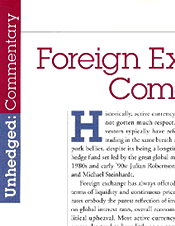Foreign Exchange Comes of Age
- 7/13/12 – New Report Suggests a Better Way to Evaluate Currency Traders
- 3/30/12 – Flexibility is Key for Currency Fund Managers
- 2/22/10 – Can the Euro Zone Cope with a National Bankruptcy?
- 3/24/09 – FX to the Fore: Risk & Return in a Post Crisis Era
- 2/18/08 – FX, A New Asset on the Menu for Investors
- 11/20/07 – Currency of Change
- 8/21/07 – Opalesque Research FX Series - II
- 8/14/07 – Opalesque Research FX Series - I
- 8/1/07 – The Perfect Portfolio Partnership
- 7/1/07 – The Risk 20 Awards: Currency Derivatives
- 5/28/07 – Russell, Hathersage Vets Seek to ID Role of FX
- 10/1/06 – Married to the Market
- 8/1/06 – How Lipschutz Downsized to Bigger Things [!]
- 6/30/06 – Foreign Exchange Comes of Age
- 6/26/06 – Hathersage Forex Trades Are All About Options
- 4/5/06 – Changes in FX Market May Cause Shakeout
- 3/30/06 – Slumping FX Funds Bet on Soft Dollar, Emerging Mkts [/!]
By Bill Lipschutz
Historically, active currency management has not gotten much respect. Institutional investors typically have referred to currency trading in the same breath as exchange-traded pork bellies, despite its being a long time favorite of the hedge fund set led by the great Global Macro traders of the 1980s and early ‘90s: Julian Robertson Jr., George Soros and Michael Steinhardt.
Foreign exchange has always offered a deep market in terms of liquidity and continuous price action. Exchange rates embody the purest reflection of investor expectations on global interest rates, overall economic growth and political upheaval. Most active currency investment programs also tend to have little or no correlation with stock and bond markets and no correlation with other hedge fund strategies. None of this, however, has been enough to entice pension funds and other institutions to consider currencies an asset class worthy of specific portfolio allocation. At least, not until recently.
During the past year a growing number of sophisticated pension funds, endowments and insurance companies have begun to seek exposure to active currency management as part of their overall investment mandate. The change has been driven in large part by the challenging task of generating absolute returns in what has generally been a low-return, low-volatility environment. Combine that with the overcrowding among many core hedge fund strategies like convertible arbitrage and risk arbitrage, and it becomes clear why active currency management is becoming an attractive way for investors to find a pure source of alpha.
The current environment is yielding some of the best opportunities I have witnessed in the nearly 25 years I’ve been active in the currency-trading business. Perhaps the most compelling reason is that the low-return, low-volatility environment that I referred to earlier has itself begun to change. With global interest rates rising toward historically normal levels for the first time in a decade, commodity-price-led inflation just around the corner and even more interest rate hikes likely to come, global markets are likely moving into a sustained period of substantially higher volatility across most major asset classes – in particular, foreign exchange.
Before the late ‘90s, volatility in the major Group of Seven currency pairs, such as the British pound-U.S. dollar and the yen-U.S. dollar, was usually 12 to 14 percent. Since the late 1990s, however, volatility has been mostly single digits. With a return to historical norms in global interest rates, we should expect both higher volatility and higher returns in G-7 foreign exchange than we’ve seen during the last ten years.
Not surprisingly, a rush of new managers is entering the currency fray. Managers who have had success in other asset classes and who have substantial assets to put to work are increasingly trying their hands at trading currencies. As with other strategies that have come of age, not all of the managers now rushing in have the skills set needed to manage a dedicated currency portfolio. Many of them only have experience doing overlay: setting up foreign exchange positions to manage the risk of adverse currency movements for investors with international portfolios.
Managing foreign exchange solely in an overlay capacity is very different from managing an active currency portfolio to extract alpha and produce absolute returns. An overlay manager hedges the foreign exchange component of an existing investment for an investor in an asset class that is not denominated in the investor's home currency. Success is usually measured against a benchmark. By contrast, active currency management attempts to profit from positions in the foreign exchange market - success is simply finishing in the black.
The flood of new active currency managers has been accompanied by a corresponding wave of new foreign exchange investment programs, made possible by advances in technology. Long-term performance records, however, are few and far between. Investors should be wary of the increasingly common practice of presenting new programs with back-tested pro forma results and need to assess carefully whether those investment results have a good chance of being replicated.
This is an exciting and extraordinary time to be actively engaged in the foreign exchange markets. A growing number of the world’s very best institutional investors agree, backing up their conviction with real mandates as currency trading finally starts to get the respect it so richly deserves.
Bill Lipschutz is a principal and the director of portfolio management at Hathersage Capital Management, a South Norwalk, Connecticut-based absolute-return manager specializing in foreign exchange.

